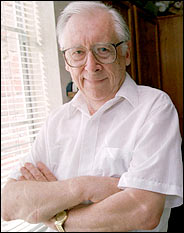|
|
|
|
Sir John A. Pople, 78, Who Won
Nobel Chemistry Prize, Dies
|
||||
 |
||||
|
John
A. Pople, a mathematician who became a chemist and won a Nobel Prize in
1998 for a computerHYI tool that describes the dance of molecules in chemical
reactions, died Monday at his daughter's home in Chicago. He was 78.
The cause of death was liver cancer, his family said. Dr. Pople was among the first to realize the potential of computers in chemistry. The behavior of all molecules is defined by the Schrodinger equation, the fundamental formula of quantum mechanics. But the equation is impossible to solve exactly except in the simplest cases. In the 1960's, Dr. Pople developed methods for calculating approximate solutions, determining the orbits of electrons zipping around molecules. From the electron orbits, the computer program predicts properties of the molecules, including whether they are stable, which colors of light they will absorb or emit, and the pace of chemical reactions. The work culminated in a program, Gaussian-70, published in 1970. That program and succeeding versions have become a common tool for chemists. "It's literally thousands of chemists worldwide who are using the results of Pople's research," said Dr. Stuart W. Staley, a professor of chemistry at Carnegie-Mellon University in Pittsburgh, where Dr. Pople taught for many years. "It's had a tremendous impact." In recent years, however, Dr. Pople was not among its users. In 1991 he left Gaussian Inc., a company set up to market the computer program. "There were disagreements about how the company should grow, and so he parted ways with other founders of the company," said Michael J. Frisch, president of Gaussian and a former student of Dr. Pople. When Dr. Pople helped found a competing company, Q-Chem, in 1993, Gaussian declined to license newer versions of its software to him. Born on Oct. 31, 1925, in Burnham-on-Sea, a small town on the west coast of England, John Anthony Pople (pronounced POPE-el) was the first in his family to attend college, graduating with a bachelor's degree in mathematics from Cambridge University in 1946. He completed his doctoral degree at Cambridge in 1951 and continued working there through 1958. He left Cambridge to head the basic physics division at the National Physical Laboratory in England, and in 1964 he became a professor of chemistry at the Carnegie Institute of Technology, now part of Carnegie-Mellon University. In 1993 he moved to Northwestern University. He remained a British citizen after moving to the United States, and last year he was knighted for his chemistry achievements. Sir John's wife, Joy, died in 2002 after nearly 50 years of marriage. He is survived by his daughter, Hilary; three sons, Adrian, who lives in Ireland; Mark, of Houston; and Andrew, of Pittsburgh; 11 grandchildren; and a great-granddaughter. Sir John's interest in the puzzles of physical chemistry, as opposed to abstract mathematics, dated from early in his career. His doctoral thesis, for instance, explored the structure of water. "I had clearly changed from being a mathematician to a practicing scientist," he wrote in an autobiography on the Nobel Prize Web site. "Indeed, I was increasingly embarrassed that I could no longer follow some of the more modern branches of pure mathematics, in which my undergraduate students were being examined." |
||||